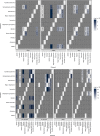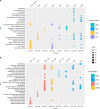A single-cell atlas of the human substantia nigra reveals cell-specific pathways associated with neurological disorders
- PMID: 32826893
- PMCID: PMC7442652
- DOI: 10.1038/s41467-020-17876-0
A single-cell atlas of the human substantia nigra reveals cell-specific pathways associated with neurological disorders
Abstract
We describe a human single-nuclei transcriptomic atlas for the substantia nigra (SN), generated by sequencing approximately 17,000 nuclei from matched cortical and SN samples. We show that the common genetic risk for Parkinson's disease (PD) is associated with dopaminergic neuron (DaN)-specific gene expression, including mitochondrial functioning, protein folding and ubiquitination pathways. We identify a distinct cell type association between PD risk and oligodendrocyte-specific gene expression. Unlike Alzheimer's disease (AD), we find no association between PD risk and microglia or astrocytes, suggesting that neuroinflammation plays a less causal role in PD than AD. Beyond PD, we find associations between SN DaNs and GABAergic neuron gene expression and multiple neuropsychiatric disorders. Conditional analysis reveals that distinct neuropsychiatric disorders associate with distinct sets of neuron-specific genes but converge onto shared loci within oligodendrocytes and oligodendrocyte precursors. This atlas guides our aetiological understanding by associating SN cell type expression profiles with specific disease risk.
Conflict of interest statement
The authors declare no competing interests.
Figures





Comment in
-
Oligodendrocytes, a New Player in the Etiology of Parkinson's Disease.Mov Disord. 2021 Jan;36(1):83. doi: 10.1002/mds.28393. Epub 2020 Nov 18. Mov Disord. 2021. PMID: 33206396 No abstract available.
References
Publication types
MeSH terms
Grants and funding
- MR/N029453/1/MRC_/Medical Research Council/United Kingdom
- G1000691/MRC_/Medical Research Council/United Kingdom
- MR/P007058/1/MRC_/Medical Research Council/United Kingdom
- H-1301/PUK_/Parkinson's UK/United Kingdom
- MR/L023784/1/MRC_/Medical Research Council/United Kingdom
- J-0901/PUK_/Parkinson's UK/United Kingdom
- WT_/Wellcome Trust/United Kingdom
- MC_EX_MR/N50192X/1/MRC_/Medical Research Council/United Kingdom
- MR/L023784/2/MRC_/Medical Research Council/United Kingdom
- MR/M024962/1/MRC_/Medical Research Council/United Kingdom
- MR/L022656/1/MRC_/Medical Research Council/United Kingdom
- 203141/Z/16/Z/WT_/Wellcome Trust/United Kingdom
- DH_/Department of Health/United Kingdom
LinkOut - more resources
Full Text Sources
Medical
Molecular Biology Databases
Miscellaneous

